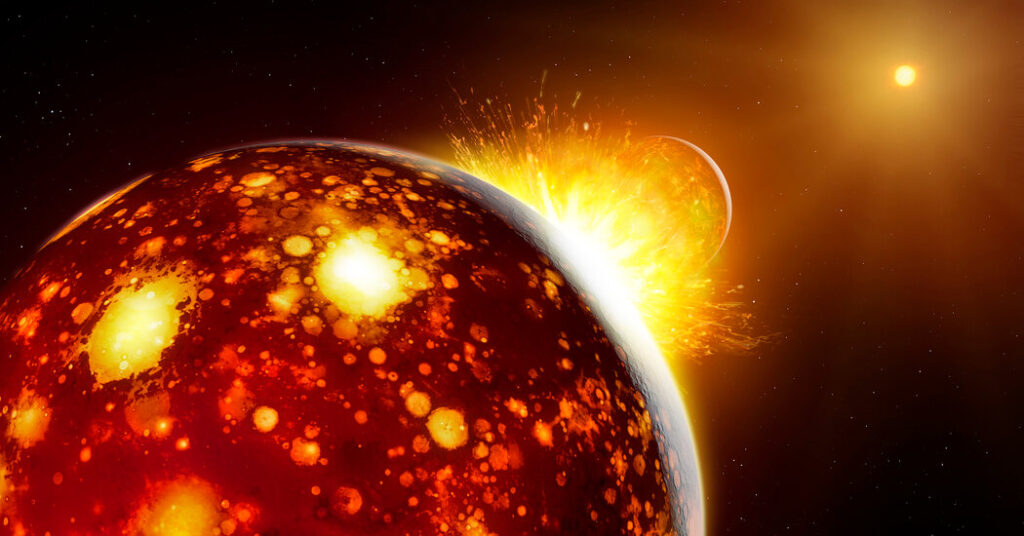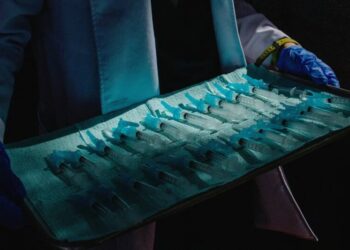Not long after Earth formed, it received an almighty sucker punch when an object roughly the size of Mars slammed right into it. The interloper, known as Theia, was destroyed, and parts of it and Earth were sprayed into space. The result was the moon.
It’s a violent, elegant theory for how Earth got its moon. But many questions about this moon-making cataclysm remain. One important unanswered query: Where in the solar system did Theia come from?
A study published Thursday in the journal Science may help answer this and other questions about this cosmic scuffle. By looking at chemical clues hidden in Earth’s rocks, meteorites and moon matter, scientists have found ghostly remnants of Theia. And they show that Theia and the early Earth were built from the same construction materials.
That explains why the chemistry of moon rocks is so similar to Earth’s: Theia’s impact on a chemically similar Earth would make a moon that resembled both orbs.
This also means that Earth and Theia took shape in the same part of space, in a swirl of dust and gas next to an adolescent sun, in what we now call the inner solar system.
Although there are several hypotheses as to how Earth got its moon, Theia is the prime suspect. The proposed object explains much about the Earth-moon system, and the solar system’s planet-making era “resembles a vast cosmic billiard game,” said Nicolas Dauphas, a cosmochemist at the University of Hong Kong and an author of the new study.
Back then, giant impacts were commonplace. Eventually, these dropped off — but they didn’t disappear entirely. “Earth happened to have been hit by a late one,” said Thorsten Kleine, a geochemist at the Max Planck Institute for Solar System Research in Germany and an author of the new study.
Computer impact simulations usually (but not always) forge a moon that is made mostly of Theia. That has been a sticking point because the moon, chemically, has much in common with Earth’s mantle, the putty-like layer below the crust on which we live.
Trying to solve this puzzle is “really, really hard,” said Paul Byrne, a planetary scientist at Washington University in St. Louis who was not involved with the new study. Apart from two inaccessible giant blobs sitting on Earth’s core, which could be surviving fragments, Theia no longer exists — at least not in a way that can be directly studied. “But that doesn’t mean it’s not worth trying,” he said.
For the new study, scientists zeroed in on the iron content of Earth and moon rocks.
When Earth was still forming, iron that was initially present trickled down into the core, where it remains today. But Earth’s mantle also has a substantial amount of iron. It doesn’t make sense that so much would have been left behind as Earth’s core formed, because the dense iron droplets should have made their way down toward it. That means a large fraction of Earth’s mantle iron must have come from an extraterrestrial source at a later date.
Theia is a handy explanation for that mantle iron, which in turn can hint at the overall makeup of the kamikaze object.
Iron comes in different forms. If the iron mixtures of mantle-derived Earth rocks and lunar rocks were found to be comparable, that would suggest the Earth, Theia and the moon were made from the same foundational stuff. The team found them to be virtually indistinguishable.
The iron signatures of all three are also a close match to those found within meteorites known as non-carbonaceous chondrites. These space rocks formed close to the sun during the solar system’s early days. That suggests Earth and Theia first appeared in the same sun-kissed part of space.
Earth is also oddly enriched in material created by a type of nuclear reaction inside stars. The young Earth formed in the vicinity of the sun, but it shouldn’t have quite this much solar spice. The researchers think this extra seasoning also came from Theia, meaning the object formed even closer to the sun than Earth did.
“They’ve certainly done a lot of work, taking a smorgasbord of samples and trying to make sense of it all,” Dr. Byrne said. But this new history of the collision of Earth and Theia is still filled with questions that, owing to Theia’s self-vaporization, may never be resolved.
“The past really is lost to us,” Dr. Byrne said — but at least we have an argent moon to admire in the present.
The post The Moon Was an Inside Job appeared first on New York Times.




